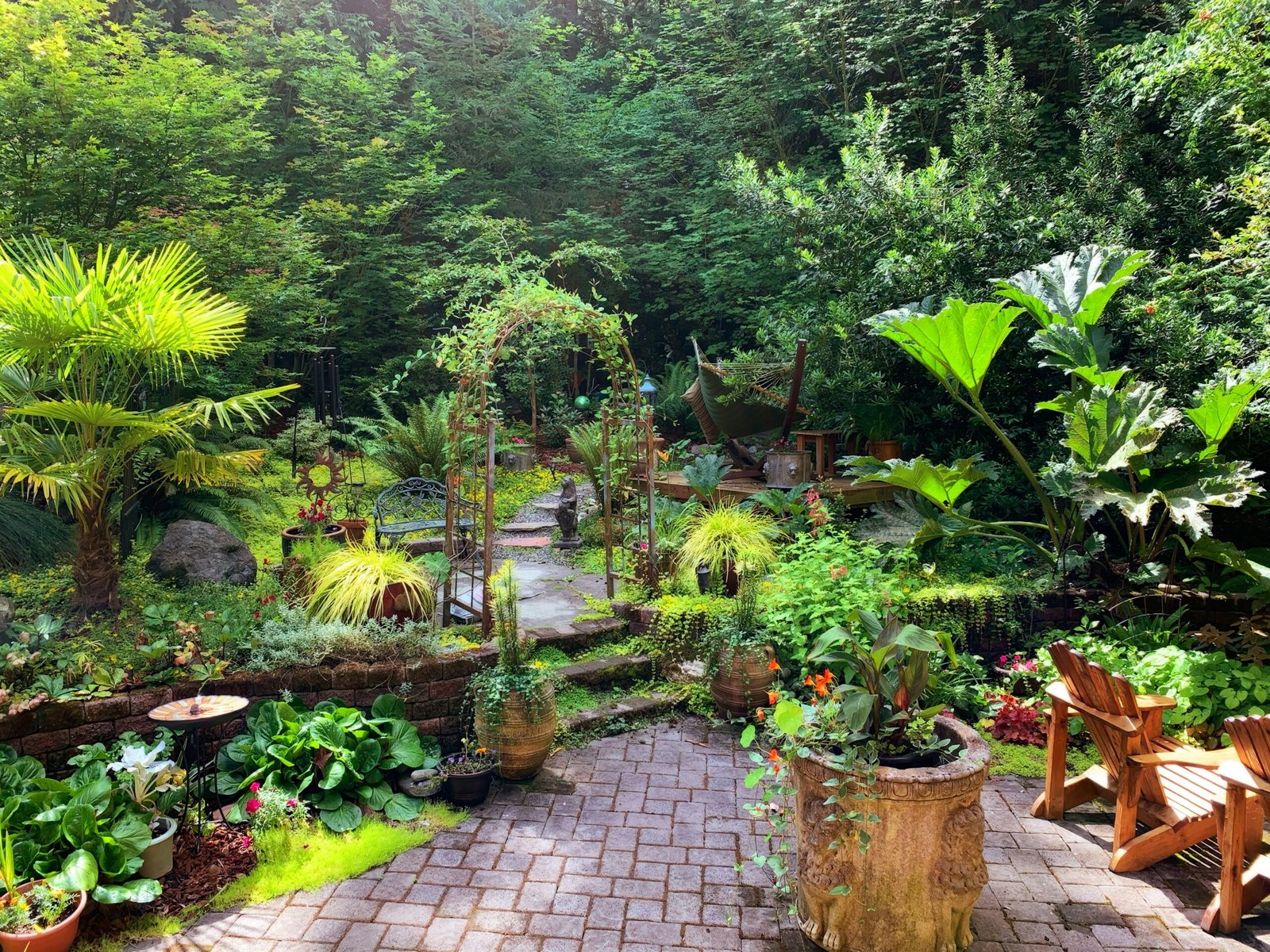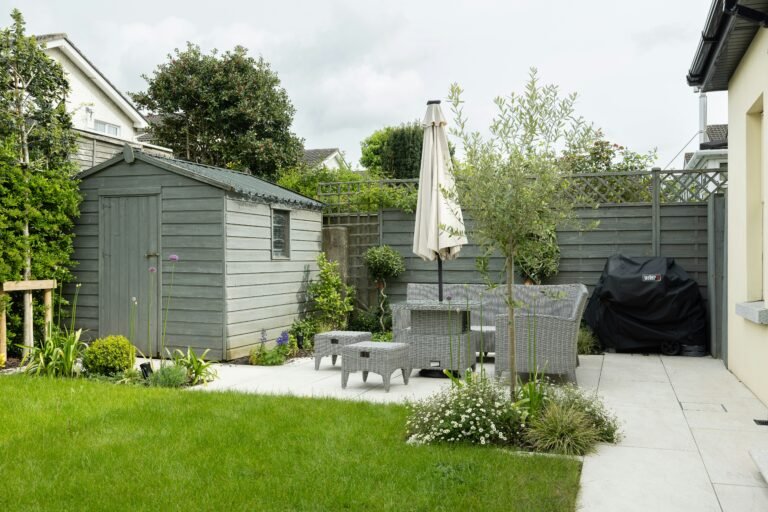A rain garden is a shallow, landscaped depression designed to collect and absorb rainwater from roofs, driveways, and patios. Instead of allowing stormwater to run off into drains — carrying pollutants into local streams — a rain garden slows, filters, and returns that water to the ground naturally. When I built my first one, I was amazed at how effectively it managed puddles in my yard while adding color and life to an otherwise dull corner.
How Rain Gardens Manage Stormwater Runoff
The principle is simple but powerful: rainwater flows into the garden, temporarily pools, and gradually seeps into the soil within 24–48 hours. Beneath the surface, layers of sand, compost, and native soil encourage infiltration and root growth. This process filters out sediments and pollutants, protecting groundwater quality. According to the U.S. Environmental Protection Agency (EPA), rain gardens can absorb up to 30% more water than a traditional lawn. For more ways to save water across your landscape, see Xeriscaping Ideas: Low-Water Gardening Tips for Drought-Proof Yards.
Key Components of a Rain Garden
Every effective rain garden includes:
- Inlet: Directs rainwater from downspouts or driveways
- Basin: The main area where water collects and slowly drains
- Soil mix: A blend of sand, compost, and loam for rapid infiltration
- Overflow outlet: Allows excess water to exit safely during heavy rains
These elements work together to mimic natural water cycles — transforming runoff into a resource rather than a nuisance.
When a Rain Garden Is (and Isn’t) the Right Solution
Rain gardens shine in areas where water tends to collect temporarily but doesn’t stay stagnant for long periods. They’re ideal for managing moderate runoff and improving biodiversity. However, avoid placing one directly over septic systems, near foundations, or on compacted clay where drainage is extremely poor. A simple percolation test (dig a hole, fill it with water, and time its drainage) will tell you whether your site is suitable.
Tip: If the water drains within 24 hours, you’re good to go. If it takes longer, consider soil amendments or a raised design.
Choosing the Right Spot for Your Rain Garden
Selecting the perfect location for your rain garden is as crucial as the design itself. I learned this the hard way — my first attempt was too close to a slope, which caused water to flow past the basin instead of into it. Getting placement right ensures proper drainage, healthy plants, and long-term success.
Site Selection: Distance, Slope, Utilities & Soil
Start by observing how rainwater moves through your landscape. Ideally, the rain garden should sit 10–15 feet away from your home’s foundation and downhill from a runoff source (like a downspout or driveway). A gentle slope — about 5% or less — is best for water flow.
Before digging, call your local utility company to mark underground lines. Then, perform a soil test: dig a small hole (about 12 inches deep) and fill it with water. If it drains within 24 hours, your site is suitable. For heavier clay soils, consider amending with sand and compost to improve infiltration.
If your yard is mostly flat, you can create subtle contours to guide runoff toward your rain garden. Tools like a line level or a simple string level help you measure slope accurately.
Sizing Your Rain Garden for Runoff
The size depends on how much water you expect to collect. A good rule of thumb:
- For sandy soil → the rain garden should be 10–20% of the area draining into it
- For clay soil → 20–30% may be needed since water drains slower
For instance, if 500 square feet of roof drains toward the garden and you have loamy soil, aim for around 75–100 square feet of garden surface. The depth should range between 4–8 inches, allowing the right amount of temporary ponding.
Permits, Local Codes & Neighborhood Considerations
In some municipalities, building a rain garden near storm drains, sidewalks, or property lines may require a permit or inspection. Check your local environmental or stormwater department for guidelines.
If you live in a neighborhood with an HOA, share your plan — most are receptive once they understand the eco-friendly benefits, such as reduced runoff, improved aesthetics, and habitat for pollinators.
Pro Tip: Take photos before and after installation — not only to document progress but also to apply for potential green landscaping rebates offered by local governments or utilities.
How to Build a Rain Garden: Step-by-Step
Once you’ve chosen the right location, it’s time to bring your rain garden to life. Building one is surprisingly achievable — even for DIY beginners. When I created mine, I followed a few clear stages: layout, excavation, soil prep, planting, and finishing touches.

Marking the Layout, Digging the Basin & Setting Overflow
Start by sketching the outline of your rain garden using stakes and string or a garden hose. Curved, natural shapes blend beautifully into the landscape and mimic natural wetlands.
Next, dig the basin to your target depth (typically 4–8 inches) and ensure the bottom is level. As you dig, use the removed soil to form a berm (a small ridge) on the downhill side — this helps hold water in during storms.
Install an overflow outlet on one side so excess water can safely drain away once the basin fills. A small trench lined with gravel or river rock works perfectly.
Soil Mix & Grading for Healthy Drainage
A rain garden’s performance depends on its soil. Mix your native soil with 50–60% sand, 20–30% compost, and 10–20% topsoil for optimal infiltration. This blend prevents standing water while keeping enough nutrients for plants to thrive.
Grade the basin gently from edges to center, ensuring that water flows inward. The final surface should resemble a shallow bowl. Before planting, water the area thoroughly to check that water settles evenly. If it pools on one side, adjust your grading.
Mulching, Edging & First-Watering Checklist
After planting (we’ll cover plant selection next), spread 2–3 inches of shredded hardwood mulch. Mulch prevents erosion, conserves moisture, and adds a finished look. Avoid fine mulch, which can float away during rain.
Add natural edging — stones, logs, or metal edging — to separate your rain garden from the surrounding lawn. Then, water deeply after planting, even if rain is in the forecast. This helps settle soil and remove air pockets around roots.
✅ Quick Build Checklist
- Mark and shape your rain garden outline
- Dig basin (4–8 inches deep) and create berm
- Test overflow drainage
- Blend and add soil mix
- Mulch and edge for structure
- Water deeply to establish plants
Resource: The University of Wisconsin Extension Rain Garden Manual offers excellent diagrams and design templates for DIYers.
Rain Garden Plants & Design Ideas
Now comes the fun part — choosing rain garden plants that bring your eco-friendly landscape to life. A well-planned garden doesn’t just manage stormwater runoff; it becomes a mini ecosystem buzzing with pollinators, songbirds, and seasonal color. I’ve found that the right plant mix transforms a practical project into something truly beautiful.
Picking Rain Garden Plants by Zone and Microclimate
Start with your USDA hardiness zone (or local equivalent) to select plants that thrive in your region. Rain gardens experience both wet and dry cycles, so look for species tolerant of temporary flooding and drought.
For example:
- Full sun, wet conditions: Blue flag iris, switchgrass, cardinal flower
- Part shade: Joe Pye weed, columbine, sedges
- Dry edges: Black-eyed Susan, coneflower, little bluestem
Native plants are always the best bet — they’ve adapted to local soils and rainfall patterns, requiring less maintenance. The Lady Bird Johnson Wildflower Center offers an excellent searchable plant database by region.
Not sure which species to choose? Start with region-ready picks in Why Native Plants Belong in Your Garden (And the Best Ones to Grow).
Layered Design: Structure, Color & Biodiversity
Design your rain garden in layers for visual interest and resilience:
- Center (wettest zone): Deep-rooted plants that handle pooling water
- Mid-zone: Grasses and moisture-loving perennials that stabilize soil
- Outer edge: Drought-tolerant plants forming a soft border
I like to combine textures — tall rushes beside broad-leafed irises, punctuated by colorful blooms like bee balm or purple coneflower. Seasonal variation ensures your garden looks alive year-round, from early spring shoots to autumn seed heads for birds.
Want your rain garden to buzz with life? Build in continuous bloom and habitat using How to Create a Pollinator Friendly Garden for Bees & Butterflies.
Native vs. Ornamental Choices & Pollinator Picks
You don’t need to avoid ornamentals altogether; mixing a few can add vibrancy. The key is balance — aim for 70–80% native species.
Try pairing natives like blazing star or swamp milkweed with ornamental grasses or daylilies for a layered, dynamic look. Avoid invasive species (like yellow flag iris or purple loosestrife) that disrupt local ecosystems.
Tip: Choose plants with overlapping bloom times so your garden supports bees and butterflies from spring through fall. The visual payoff is stunning — and the environmental benefits are even better.
Rain Garden Maintenance, Costs & Incentives
Building a rain garden is just the start — maintaining it ensures long-term beauty and function. Fortunately, upkeep is far easier than a traditional lawn once your plants mature. My own rain garden now thrives with just a few hours of care each season, and the rewards are immense: no standing water, no runoff, and a yard full of life.

Year-One Care: Weeding & Watering Schedule
The first year is about establishment. Water your new garden weekly during dry spells so roots grow deep. Mulch helps retain moisture, but you’ll still need to check that the top few inches stay damp.
Weeding is essential early on — young native plants can be slow starters, giving weeds an opening. Once plants mature, they’ll crowd out most intruders naturally.
A 3-step routine for year one:
- Water once a week (unless it rains an inch or more).
- Pull weeds by hand before they seed.
- Top up mulch in late summer if erosion occurs.
Long-Term Upkeep: Sediment, Mulch & Plant Division
After the first year, maintenance drops significantly. Each spring:
- Inspect inlets and outlets to clear debris or sediment buildup.
- Refresh mulch every 1–2 years to control weeds and retain moisture.
- Trim dead stems in late winter to encourage new growth.
- Divide crowded perennials every 3–4 years to maintain vigor.
Avoid fertilizing — compost and leaf litter usually provide all the nutrients your garden needs.
Budget, DIY vs. Pro Costs & Incentives
A DIY rain garden typically costs $3–$6 per square foot, depending on materials and plant selection. Professional installation can range from $10–$20 per square foot, especially if excavation or drainage work is needed.
Check with local governments — many cities offer rebates or grants for eco-friendly landscaping. For example, the EPA’s Green Infrastructure Program highlights regional initiatives that help homeowners offset costs.
Pro Tip: Keep receipts and take photos of progress — they’re often required for rebate applications and make great reference for future tweaks.
With minimal maintenance, your rain garden will mature into a self-sustaining habitat that enhances both your home’s value and the local environment.
Troubleshooting & Common Mistakes in Rain Garden Projects
Even a well-planned rain garden can face challenges, especially in the first year. The good news? Most issues are easy to fix once you understand what’s happening beneath the surface. I’ve made a few of these mistakes myself — and each taught me something valuable about how water, soil, and plants work together.
Poor Infiltration & Standing Water
If your rain garden holds water for more than 48 hours, drainage is likely too slow. This can happen when:
- The soil mix contains too much clay
- The basin was compacted during digging
- The site’s slope is too low for good flow
Solutions:
Loosen compacted areas with a garden fork, add coarse sand and compost, or install a small underdrain filled with gravel. For heavy soils, you can also build a raised rain garden to improve infiltration.
Plant Failure & Mosquito Myths
If plants look wilted or yellowed, they may be mismatched to your moisture zones. Move water-loving species to the basin center and drought-tolerant ones to the edges. Avoid overwatering — once roots establish, rainfall is usually enough.
As for mosquitoes: properly designed rain gardens do not breed them. The water drains too quickly for larvae to mature. According to the EPA’s Soak Up the Rain program, rain gardens can reduce mosquito populations by eliminating standing puddles elsewhere in your yard.
Overflow, Erosion & Edge Damage
Heavy rain can sometimes wash out mulch or create erosion near the inlet. The fix? Add river rocks or gravel at the entry point to slow incoming water. Reinforce berms with native grasses whose roots stabilize the soil naturally.
Regularly inspect your overflow outlet after big storms — it’s your garden’s “pressure release valve.” A blocked outlet can cause flooding or erosion, so clear leaves and sediment promptly.
Seasonal Adjustments: Storms, Droughts & Freezes
- During heavy storms: Check that water flows in and out evenly.
- In droughts: Water deeply once a month to protect root systems.
- Before winter: Trim stems but leave seed heads — they feed birds and provide winter interest.
Remember: Every rain garden evolves with the seasons. Small tweaks — like regrading low spots or swapping out one plant species — can make all the difference between frustration and flourishing success.
Conclusion
Creating a rain garden isn’t just about managing water — it’s about restoring balance between your home and nature. When I built mine, I didn’t expect it to become such a rewarding part of my landscape. It now hums with bees in summer, hosts sparrows in fall, and turns every rainfall into something quietly beautiful.
Rain gardens show that sustainable choices can be both practical and inspiring. By capturing stormwater runoff, they reduce flooding, filter pollutants, and replenish groundwater. With the right design, plants, and maintenance, you can transform an ordinary yard into a thriving, eco-friendly haven.
If you’re considering your own project, start small. Observe how water moves through your property after a storm, sketch a design, and choose a few resilient native plants. You’ll quickly see how even modest changes can make a visible difference — to your landscape, your community, and the planet.
Alex is the creator of Homely Haven, a space dedicated to simple, stylish ideas for interiors and gardens alike. With a passion for cozy living rooms, inviting outdoor spaces, and practical DIY solutions, Alex shares tips and guides that help turn any house into a true home.
From budget-friendly decorating hacks to weekend garden projects, the goal is always the same: to inspire you to create spaces that feel personal, beautiful, and welcoming. When not writing, Alex is usually rearranging furniture, sketching new garden layouts, or exploring design trends for the next project.








